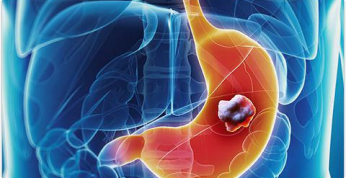Stomach Cancer


Stomach
To understand stomach cancer, it helps to know about the normal structure and function of the stomach.
The stomach is a sac-like organ that’s an important part of the digestive system.
After food is chewed and swallowed, it enters the esophagus, a tube that carries food through the throat and chest to the stomach. The esophagus joins the stomach at the gastroesophageal (GE) junction, which is just beneath the diaphragm (the thin sheet of breathing muscle under the lungs). The stomach then starts to digest the food by secreting gastric juice. The food and gastric juice are mixed and then emptied into the first part of the small intestine called the duodenum.
Some people use the word 'stomach' to refer to the belly area. The medical term for this area is the abdomen. For instance, some people with pain in this area would say they have a 'stomach ache', when in fact the pain could be coming from some other organ in the area.
Stomach cancer is different from other cancers that can occur in the abdomen, like cancer of the colon or rectum (large intestine), liver, pancreas, or small intestine. These cancers can have different symptoms, different outlooks, and different treatments.
Development of stomach cancer
Stomach cancers tend to develop slowly
Cancers starting in different sections of the stomach can cause different symptoms and tend to have different outcomes. The cancer’s location can also affect treatment options. For example, cancers that start at or grow into the GE junction are usually staged and treated the same as cancers of the oesophagus.
Adenocarcinomas
Most cancers of the stomach (about 90% to 95%) are adenocarcinomas. These cancers develop from the gland cells in the innermost lining of the stomach (the mucosa).
If you are told you have stomach cancer (or gastric cancer), it will almost always be an adenocarcinoma. The information on the following pages that discusses stomach cancer refers to this type of cancer.
There are 2 main types of stomach adenocarcinomas:
- • The intestinal type tends to have a slightly better prognosis (outlook).
- • The diffuse type tends to grow spread more quickly. It is less common than the intestinal type, and it tends to be harder to treat.
Lymphomas
These cancers start in immune system cells called lymphocytes. Lymphomas usually start in other parts of the body, but some can start in the wall of the stomach.
Stomach Cancer Risk Factors
A risk factor is anything that raises your chances of getting a disease such as cancer. Different cancers have different risk factors. Some risk factors, like smoking, can be changed. Others, like a person’s age or family history, can’t be changed.
But having a risk factor, or even several risk factors, does not mean that you will get the disease. Many people with one or more risk factors never get cancer, while others who get cancer may have had few or no known risk factors.
Sex
Stomach cancer is more common in men than in women.
Age
Stomach cancer can occur in younger people, but the risk goes up as a person gets older. Most people diagnosed with stomach cancer are in their 60s, 70s, or 80s.
Helicobacter pylori infection
Infection with Helicobacter pylori (H pylori) bacteria seems to be a major cause of stomach cancer, especially cancers in the lower (distal) part of the stomach. Long-term infection of the stomach with this germ may lead to atrophic gastritis and other pre-cancerous changes of the inner lining of the stomach.
People with stomach cancer have a higher rate of H pylori infection than people without this cancer. H pylori infection is also linked to some types of lymphoma of the stomach. Even so, most people who carry this germ in their stomach never develop cancer.
Diet
Stomach cancer risk is increased in people whose diets include large amounts of foods preserved by salting, such as salted fish and meat and pickled vegetables.
Eating processed, grilled, or charcoaled meats regularly appears to increase risk of non-cardia stomach cancers.
Eating few or no fruits likely increases the risk of stomach cancer. On the other hand, eating lots of fresh fruits (especially citrus fruits) and raw vegetables appears to lower the risk of stomach cancer.
Previous stomach surgery
Stomach cancers are more likely to develop in people who have had part of their stomach removed to treat non-cancerous diseases such as ulcers. This might be because the stomach makes less acid, which allows more harmful bacteria to be present. Reflux (backup) of bile from the small intestine into the stomach after surgery might also add to the increased risk.
Polyps are non-cancerous growths on the lining of the stomach. Most types of polyps (such as hyperplastic polyps or inflammatory polyps) do not seem to increase a person’s risk of stomach cancer much, if at all. But adenomatous polyps – also called adenomas – can sometimes develop into cancer.
Epstein-Barr virus (EBV) infection
Epstein-Barr virus causes infectious mononucleosis (also called mono). Most people are infected with this virus at some time in their lives, usually as children or teens.
EBV has been linked to nasopharyngeal cancer and to some forms of lymphoma. It is also found in the cancer cells of about 5% to 10% of people with stomach cancer, although it isn’t yet clear if the virus actually causes stomach cancer. Stomach cancers linked to EBV tend to be slower growing and have less of a tendency to spread.
Blood type groups refer to certain substances that are normally present on the surface of red blood cells and some other types of cells. These groups are important in matching blood for transfusions. For unknown reasons, people with type A blood have a higher risk of getting stomach cancer.